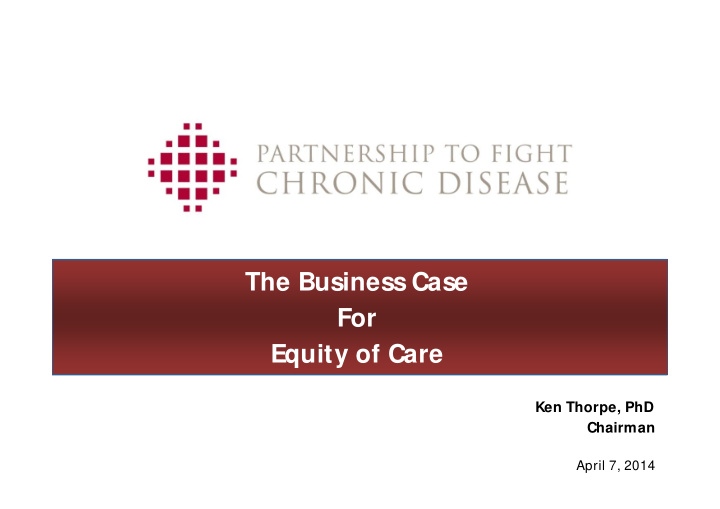



The Business Case For Equity of Care Ken Thorpe, PhD Chairman April 7, 2014
Ken Thorpe, Professor and Chair, Rollins School of Public Health, Emory University More than 100 partners ONE message
C osts Related to C hronic Disease • One in two Americans lives with a chronic condition • Chronic disease accounts for 84 percent of what is spent on healthcare in the United States • The annual amount of lost productivity due to seven of the most common chronic diseases is more $1 trillion • U.S. health spending is projected to almost double over the next ten years • Based on this prediction, U.S. health spending could reach $4.78 trillion by 2021.
Gaps in Equity Mean Large Human &Economic C osts • Each year, 7 out of 10 deaths in the U.S. are due to chronic diseases. • According to the New England J ournal of M edicine, people with chronic conditions receive only 56% of recommended preventive health care services. • Significant differences in health outcomes based on variety of factors unrelated to health • Gender • Ethnicity • Geographic location • Socioeconomic status
Determinants of Health • There are many channels through which to impact perceptions, decisions and behaviors that directly affect overall health. • Understanding these factors and their relevance is an important step in preventing chronic disease and better managing health outcomes.
Health Status &Outcomes V ary By where we live – By where we live – By racial & ethnic group – By racial & ethnic group – zip code can tell more than zip code can tell more than life expectancy, infant life expectancy, infant genetic code genetic code mortality, health outcomes mortality, health outcomes By income and education – By income and education – life expectancy, children’s life expectancy, children’s health, obesity health, obesity
“Health equity is achieved when every person has the opportunity to ‘attain his or her full health potential’ and no one is ‘disadvantaged from achieving this potential because of social position or other socially determined circumstances.’” - Centers for Disease Control&Prevention
Near in Location, Far in Outcome Babies born to mothers in M ontgomery County in M D or Fairfax and Arlington Counties, in VA can expect to live 6 to 7 years longer than babies born to mother’s in Washington, DC – just a few subway stops away. Businesses hire from all four areas. Source: Prepared by Woolf et al., Center on Human Needs, Virginia Commonwealth University using Centers for Disease Control and Prevention, National Center for Health Statistics, CDC WONDER Online Database, released January 2013. Data are compiled from Compressed M ortality File 1999-2010 Series 20 No. 2P, 2013. Accessed at http:/ / wonder.cdc.gov/ cmf-icd10.html. As appears in, RWJF Commision to Build a Healthier America, “ Overcoming Obstacles to Health in 2013 and Beyond,” (2013). * Life expectancy at birth
Health Depends on More than Medical C are • Focus a lot of attention on medical care in business: • Health coverage costs • Benefit design • Poor health has broader impact on business: • Disability • Worker’s Compensation • Health-related retirement • Absenteeism AND presenteeism • Overall productivity • Health of dependents
It’s Not J ust About the Business • Talk the talk AND walk the walk • Community environment where business is being done is equally as important • Promoting health equity • Prevention & public health • Wellness & well-being
Where Do We Go from Here
Keep the momentum going • June is National Employee Wellness M onth • Health and wellness programs are important to employees. • Incentives matter. • Communication is a concern. • M easuring impact continues to be a challenge. • Health and wellness programs have a positive impact on an organization’s culture.
The Business Case For Equity of Care Ken Thorpe, PhD Chairman April 7, 2014
Recommend
More recommend